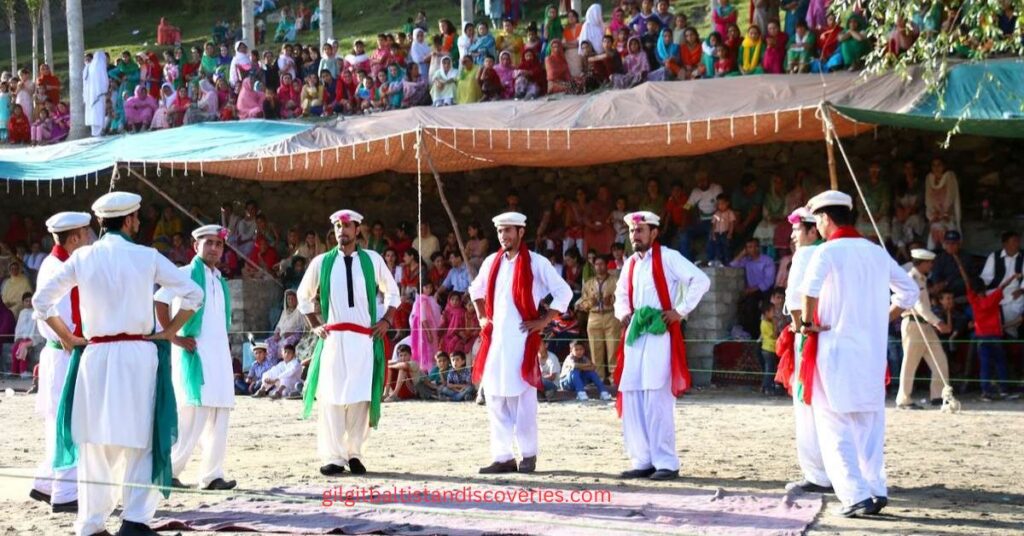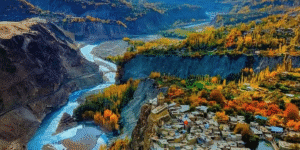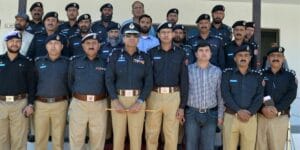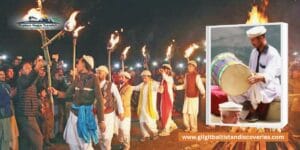Imagine being transported to a world where every marriage is more than a union. It’s an artwork, crafted with age-old customs, deep-rooted traditions, and the rich cultural heritage of Gilgit Baltistan. Sketch celebration where history dances with joy, and each tradition tells a story of love, honor, and community. Welcome to the charmed world of marriages in Gilgit Baltistan, where every marriage is colorful and a journey into the past.
In certain districts of Gilgit-Baltistan, marriages are conducted strictly according to Islamic teachings. Every part of the ceremony is celebrated in line with Islamic values, under the close supervision of scholars, which adds to the significance and memorability of the event.
From designing fancy henna patterns on hands and feet to offering emotional goodbyes. It also takes a slip look at how the marriage traditions of this peculiar region are not only preservatives of their ancestral legacy but also an affair that captures the senses and calms the heart and mind. Explore the captivating traditions of Gilgit Baltistan marriages and see how these ceremonies become unforgettable adventures!
More Read: Gilgit Baltistan People -People of the Mountains
Table of Contents
ToggleGilgit Baltistan Marriage
The wedding in Gilgit Baltistan buffered between the magnificent ranges of Karakoram and the Himalayas. It is a unique cultural activity representative of the great traditions and history and colorful festivals. Hence, the region embellishes gleaming beauty along with a rich history. Unique customs are intertwined with their traditions in this region, and marriage ceremonies highlight these bright customs.
History and Roots of Gilgit Baltistan
Marriage in Gilgit Baltistan has always reflected both the tribal nature and strategic position along historical trade routes. Consequently, these marriages now epitomize the region’s rich cultural heritage.
John Biddulph: his key work The Tribes of Hindoo Koosh (1880), recorded the prime significance of marriage in strengthening ties between tribes. Indeed, marriages were usually collaborations that helped keep peace among groups of people. Moreover, especially when Gilgit Baltistan was a key crossroads for traders, explorers, and rulers.
The isolation of the region preserved this social heritage, of which marriage remained a keystone and sometimes the core of social and political life.
As Frederic Drew pointed out in his descriptive work titled The Jummoo and Kashmir Territories in 1875. Geography played a role in forming the unique cultural customs of Gilgit Baltistan. In addition, marriages were not just related to the bride and the groom, the land, and their tribes.
Read More: History of Gilgit Baltistan- Pakistan

Family and Elders’ Role in Marriage
Conventionally, marriages in Gilgit Baltistan were not a matter of personal choice but were arranged by the family, particularly elders, at the center.
According to Abdul Hayee Jabir in his article entitled Kashmir Papers, 2001, “elders are an important entity in arranging marriages”. This also usually includes an extended negotiation between the families, taking into account the social standing, tribe, and family honor.
The Rishta, or the formal proposal of marriage, is an essential and very deeply set-in process in the cultural history of Gilgit Baltistan. In addition, the groom’s family would come to the family of the bride, presenting various gifts, often twisting through complex negotiations for approval. The exchange of symbolic items, hand-crafted goods, or traditional garments furthered this view that marriage was not a personal affair but rather one about the family.
The Traditions and Functions
Mehndi-Colourful Celebration
The Mehndi marks the start of wedding festivities days in advance of the wedding. What used to be a simple event has gradually turned into a colorful and lively function. Traditionally women of the bride’s family used to sing folk songs these songs narrate stories of old love stories, and cultural values as explained by Zain in A Socio-Political Study of Gilgit Baltistan Province 2010.
Various henna designs on the hands and feet of a bride signify beauty and joy. Traditionally, the families also used to prepare the henna themselves with raw herbs and oils available in the environment. Furthermore, drawing henna designs became a very personalized and communal activity.
Barat-Grand Procession
The most awaited part of any wedding is the arrival of the groom’s procession, known as the Barat. Traditionally, the bridegroom would ride a decorated horse, accompanied by family and friends as they made their way to the bride’s home. Indeed, this was done today as well, but horses replaced cars or other modes of modern transport. In addition, according to Biddulph (1880), this procession is invariably accompanied by the traditional instruments of local musicians who raise a joyful and merry atmosphere that resounds down the valleys.
The bridegroom’s family welcomed them at the entrance with Wakhi and Shina songs, projecting diversity into this culturally rich land. Furthermore, in the afternoon the elders prayed for the newlywed couple at the bride’s house, praying for a life filled with bliss and joy.

Nikah and Rukhsati-Binding of Two Souls
Nikah is a very traditional and highly significant Islamic marital ceremony. The husband and wife declare their marriage by signing a contract in front of family members and a religious leader. According to historian David Lorimer’s work in 1976 in his book Notes on the Bloody Partition, the marriage ceremonies are rooted in Islamic culture. Next comes Nikah, comprising prayers and blessings. In addition, the elders pour forth their heartiest wishes towards the newlywed couple.
Rukhsati- Emotional Moments
One of the most emotional moments of any marriage in Gilgit Baltistan is the Rukhsati. In which the bride has to say goodbye to her family. This is a teary-eyed and smiling moment as it marks the transition of the bride into her new house. People have been performing Rukhsati in the very same way for centuries. Moreover, they are doing so with preciseness today also. In addition, Rukhsati is one of the most emotional moments in every marriage, reflecting strong family ties.
Walima-The Grand Feast
After the marriage, there is a Walima, which is a very lavish meal provided by the groom’s family. It reflects the treasure of eatables given by Gilgit Baltistan. Traditional food includes Harissa, a meat preparation that takes at least eight hours the make, and Chapshuro, a local meat bread. Though the Walima started as a family affair, today it may include extended family, friends, and even neighbors on a pretty large-scale basis.
The Walima is the last celebration of marriages, as explained by the 2015 Government of Gilgit Baltistan report on regional customs. Therefore, It celebrates the union of the couple by both families.
Read More: 26 Famous Dishes of Gilgit-Baltistan
Changes Over Time-Modern Influence
Many traditions in Gilgit Baltistan marriages have become a thing of the past, which have given place to modern influences. Ceremonies are not as detailed and simple as they used to be in the olden days. Instead, weddings have become very lavish, and destination weddings, stylishness, and modern dressing are all part of the weddings.
The social-political study by Omer Farooq Zain (2010) describes the fact that more and more urbanization and attention to the outside world have brought considerable changes in the traditional lifestyle of this region. However, marriage in Gilgit Baltistan still honors its rich history where community and family meet culture to create an unforgettable experience.
Read More: Top Honeymoon Destinations in Gilgit Baltistan
Conclusion-Gilgit Baltistan Marriages
From the colorful Mehndi to the emotional Rukhsati, every wedding in Gilgit Baltistan sends the guest into a time-traveling. The groove reflects the rich history and vibrant culture that the region is linked with. The customs, though changing, still reflect the core of those times when marriage would not only bond two souls together but was a bond between families.
And as you imagine the celebrations, the laughter, and the tears, one would not be at fault, flowing honor for the grace in these time-worn customs. Moreover, from steeping in history to modernity, Gilgit Baltistan weddings continue to inspire respect and bring joy much as they have for centuries.
Read More: How To Travel to Gilgit Baltistan from Islamabad
Frequently Asked Questions about Marriage in Gilgit Baltistan
1. What is the significance of marriage to the people of Gilgit Baltistan?
Marriage amongst the people in Gilgit Baltistan is not between two individuals; it is a huge family and tribal union that upholds family ties. Traditionally, people used marriages to keep peace and create a strong social relationship between the two tribes. For this reason, they had a vital purpose in bringing the community together harmoniously. However, it is representative of deep-rooted cultural traditions and displays family and community celebrations.
2. What are the traditional customs followed in the wedding of Gilgit Baltistan?
Marriages in Gilgit Baltistan traditionally observe several key customs, such as:
- Mehndi: This pre-wedding custom traces the artistic henna designs onto the hands and feet of the bride.
- Barat: Second, there is barat, which means that the procession of the groom reaches the house of the bride riding a horse.
- Nikah: Nikah is an Islamic marriage where the signing of the marriage contract occurs.
- Rukhsati: This is when the bride tearfully says goodbye to her family.
- Walima: This is a grand feast given to mark this union by the groom’s family.
3. How does matchmaking take place in Gilgit Baltistan?
Conventionally speaking, matchmaking amongst the people of Gilgit Baltistan highly involves the family and elders of the two families. Also, it is the bridegroom’s family that approaches the bride’s family with formal proposals, adding gifts to it. The negotiations are mainly on status dignity and family respect. Indeed, the involvement of elders ensures that through this union, both families come out well off.
4. What is the role of the elders in marriages among the people of Gilgit Baltistan?
In every marriage that takes place in Gilgit Baltistan, elders have their significance. They find matches, bring two parties together for negotiation, and settle the aim of marriage according to family and tribal traditions. Their blessings and guidance are thus key to the success and harmony of the marriage.
5. How have modern influences affected a change in the marriage traditions of Gilgit Baltistan?
All these have introduced many changes in the traditional weddings of Gilgit Baltistan. The core customs remain safe, but destination weddings, themed decoration, and wearing of modern vital are part of the wedding celebration nowadays. Urbanization and exposure to global trends influenced such changes while maintaining the traditional essence of ceremonies intact.
6. What are some popular traditional foods included in a Gilgit Baltistan wedding?
Traditional foods included in the wedding ceremony of Gilgit Baltistan are:
- Harissa: This is a meat dish that is prepared through ongoing with spices and corn.
- Chapshuro: This is also a certain kind of bread that contains meat. They just love this dish, and as such, it is one of the most ordered and eaten at their wedding ceremonies.
- Pulao: It is also prepared with rice, meat, and spice. These dishes reflect the rich food tradition of the region and form an essential part of the marriage feast.
7. How is the Mehndi ceremony arranged in Gilgit Baltistan?
It is a very vibrant and colored event in Gilgit Baltistan. The beautiful Mehndi designs on her hands and feet are a show. Ladies from the bride’s side sing traditional folk songs. The event is joyous with festive decorations filled with color. Therefore, Traditionally they prepare henna with local herbs and oils and add their personal touch to celebrating it.
8. What is the significance of the Rukhsati in a Gilgit Baltistan marriage?
The Rukhsati is a far-from-dry-eyed incident of the marriage in Gilgit Baltistan. It is the departure of the bride from her family house to the home of the bridegroom. It is a very joyful and sorrowful farewell due to the strong family attachment and shifting role of a bride.
9. What is the difference between Walima and the wedding?
The Walima or wedding celebration dinner is arranged by the family of the bridegroom after the actual wedding, this particular feature distinguishes it from the earlier celebrations. Otherwise stated as a grand celebration of the wedding. In addition, Walima contains all types of traditional dishes and is the occasion where the extended family and friends get to participate in the wedding celebration.
10. Where can I learn more about the history and traditions of Gilgit Baltistan marriages?
You can look into the concept of marriage in Gilgit Baltistan, their background, and others from history and studies like:
- Biddulph, John. The Tribes of Hindoo Koosh, 1880.
- Drew, Frederic. The Jummoo and Kashmir Territories, 1875.
- Jabir, Abdul Hayee. Kashmir Papers, 2001.
- Zain, Omer Farooq. A Socio-Political Study of Gilgit Baltistan Province, 2010.
- Government of Gilgit Baltistan. Gilgit Baltistan, 2015.
In addition, these sources are a reflection of the historical and cultural background represented in the marriage traditions in the area.







